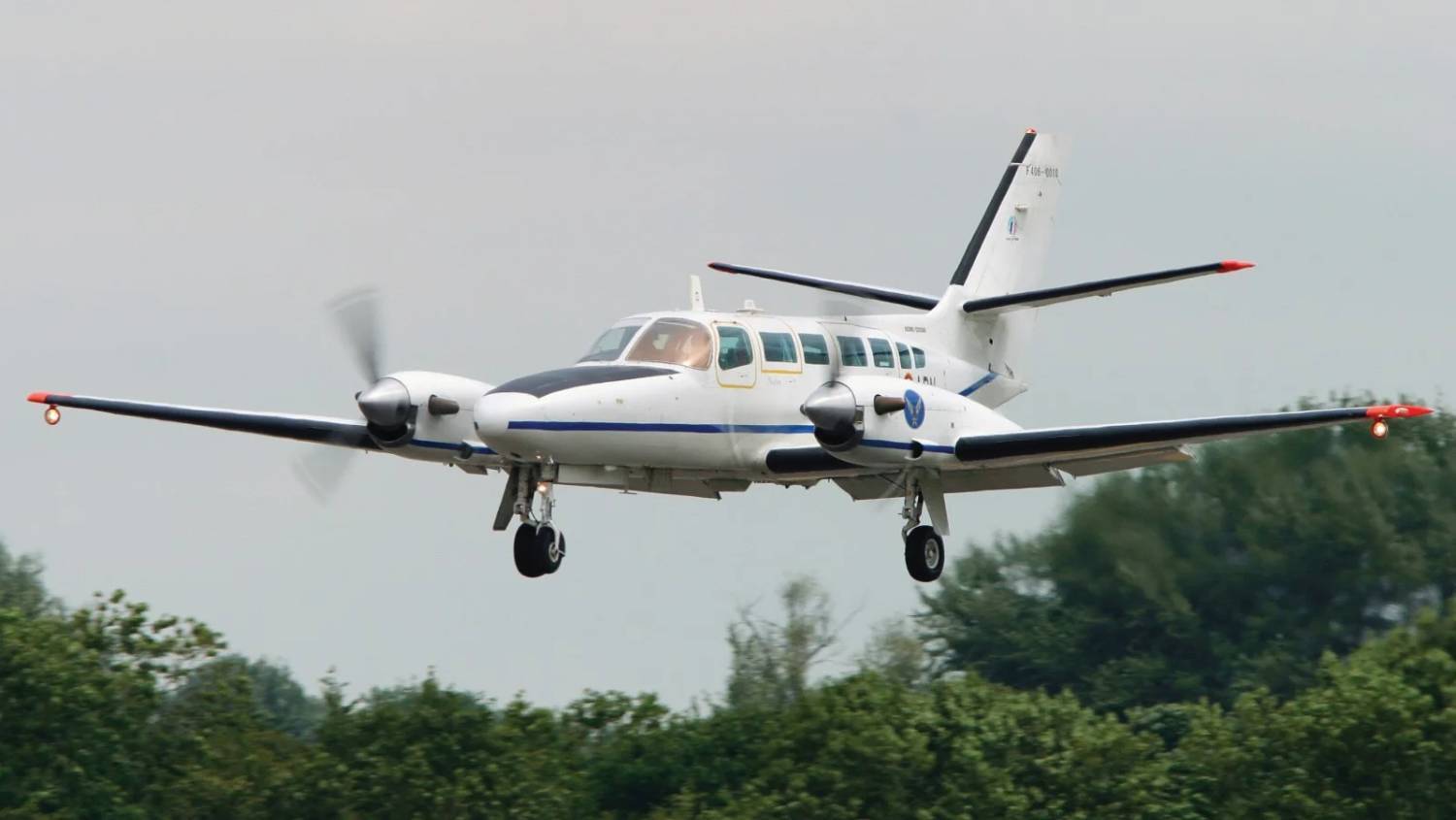
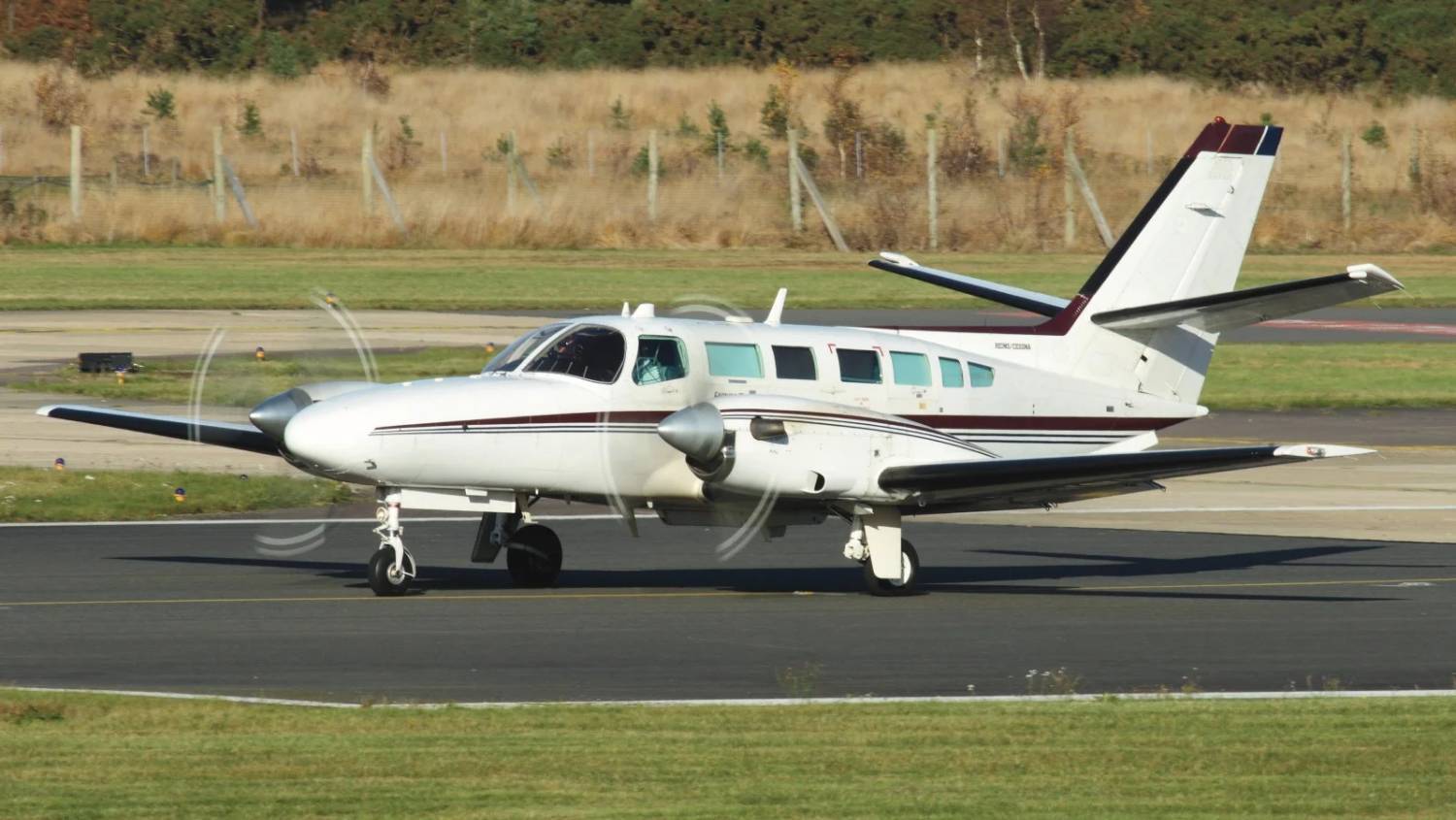
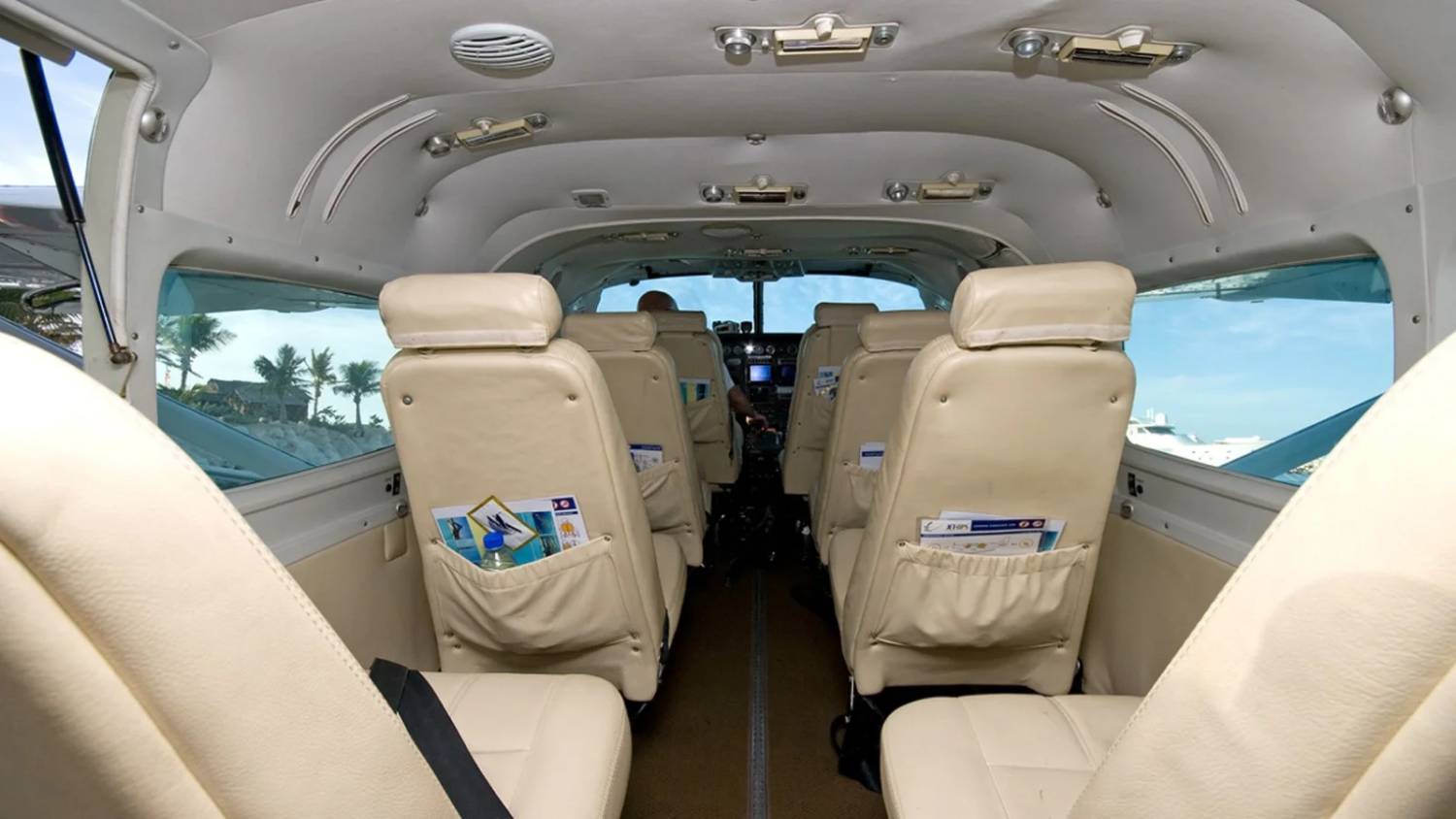

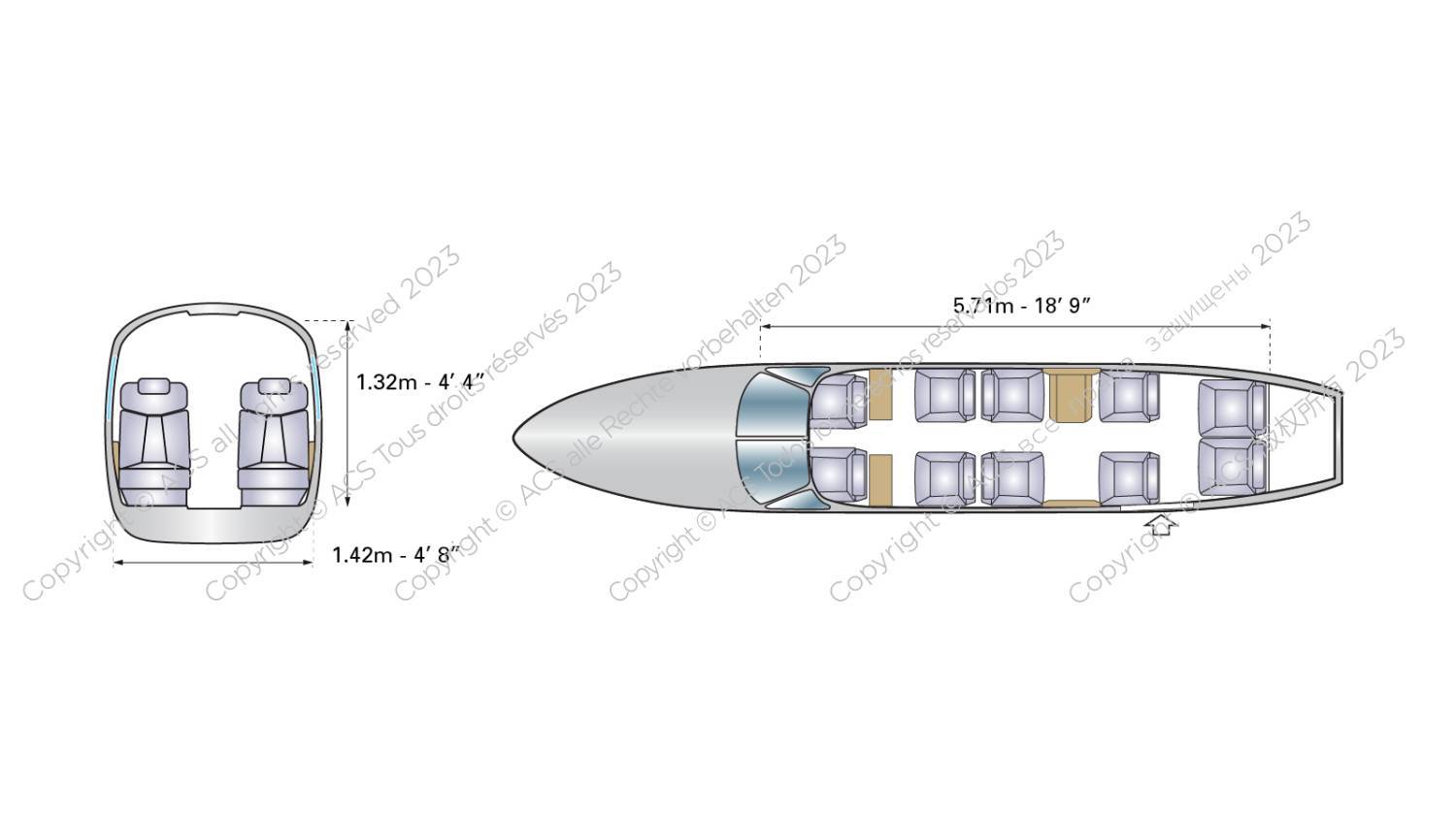
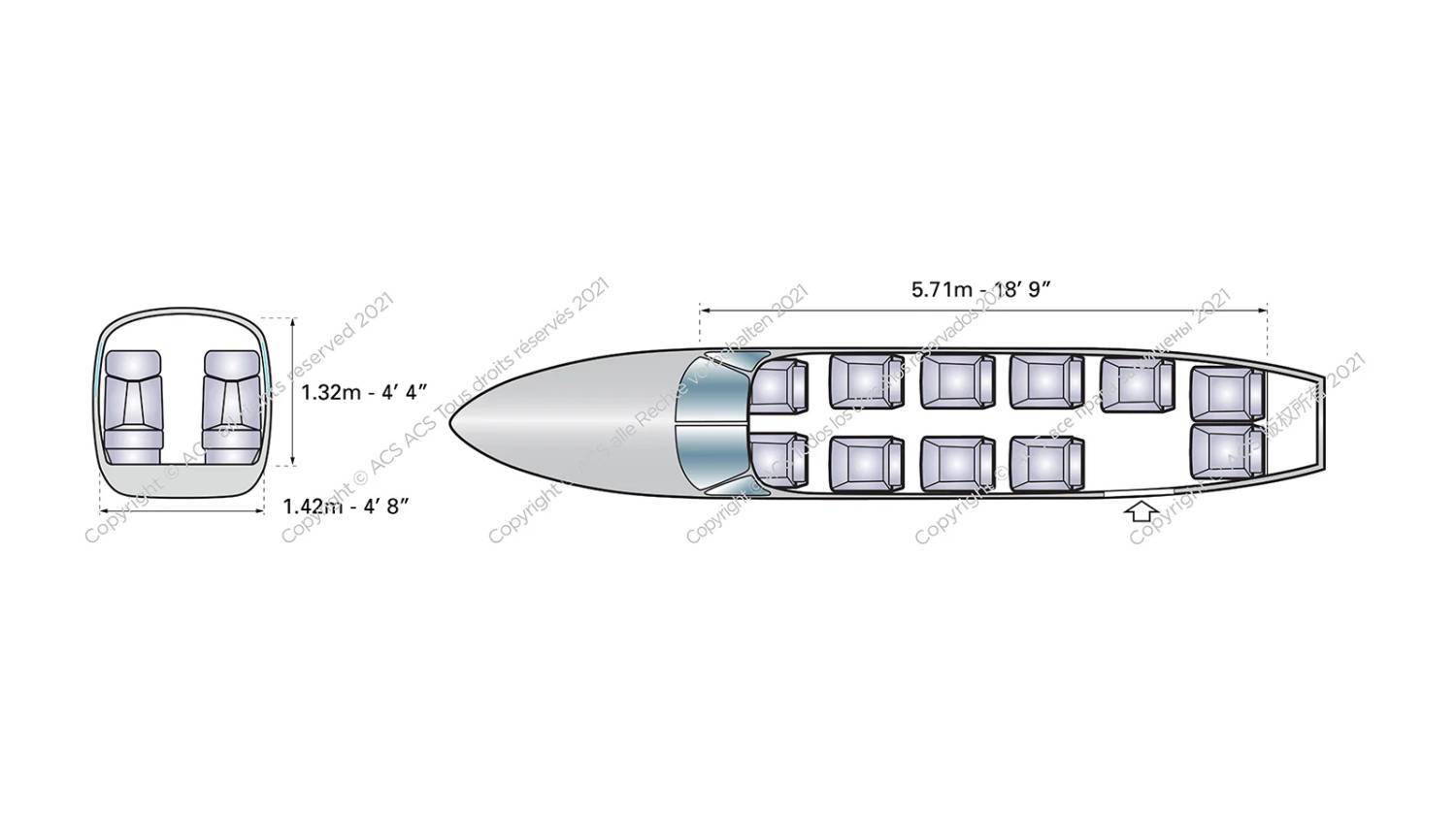
CESSNA F406 CARAVAN II
介紹
- Passengers 10
The Reims-Cessna F406 Caravan II (or Cessna F406) is a twin-engine turboprop utility aircraft manufactured by Reims Aviation in collaboration with Cessna.
About this aircraft
- The first Reims-Cessna F406 Caravan II was built in 1983 as a development of the piston propeller Cessna 404 Titan.
- The Cessna F406 Caravan II can be configured for 12 passengers, but most seat eight to 10. An executive variant can seat six or seven people.
- The F406 can fly non-stop from London to Nice or New York to Boston.
- Luggage space varies, but the aircraft can hold around eight suitcases with a cargo pod attached.
- Production of the aircraft ended in 2013 after Reims Aviation filed for bankruptcy.
Having two engines makes the Reims-Cessna F406 Caravan II more costly to operate than the single-engine Cessna 208 Caravan, but gives it greater durability and power.
Interior design

The Cessna F406 Caravan II’s cabin is 5.71 metres long, 1.42 metres wide and 1.32 metres high. The commuter version can accommodate up to 12 passengers and two crew in a 1-1 formation, while an executive layout offers more legroom with only six or seven seats. Other configurations seat eight or nine.
The cabin is fitted for passenger comfort and safety, with wide windows for each seat, air conditioning, lighting, lighted signs, four emergency exits and a baggage locker.
Below are typical configurations found inside a Cessna F406 Caravan II.



Interesting facts to learn before you fly
- Newer and refurbished models may have screens and a quieter, more modern cabin.
- The Cessna F406 is highly adaptable and can handle rough ground.
- A cargo pod can be added to the belly of the aircraft for additional cargo capacity, bearing up to 320 kg of general freight or passenger bags.
Technological features
The original Cessna F406 Caravan II is powered by two 500 SHP Pratt & Whitney Canada PT6A-112 turboprops with three blade propellers that provide 500 horsepower.
Numerous avionics have been available over the years, including the Silver Crown classic avionics suite, Silver Crown plus radios, and EFIS with 2 digit tube displays. Some special-use aircraft feature FMS integrated GPS and GLONASS receiver systems, while others have a Garmin GNS 530W package.
History
The F406 Caravan II was originally conceived as a twin-engine aircraft to complement Cessna’s single-engine C208 Caravan I, but became increasingly unique as the design evolved. Cessna sold the manufacturing rights to Reims Aviation shortly after the design was finalised and the aircraft made its maiden flight in September 1983.
The F406 Caravan II has room for up to 14 passengers and a maximum rated payload capacity of over 1,800 kg. These features, combined with its relatively low cost, made the aircraft popular with regional carriers across Africa and Asia. It’s also favoured within the European Union as it complies with the region’s instrument-only commercial flight restrictions, unlike single-engine rivals. The F406 has been used by the French and Korean militaries, as well as by French, British and Greek coastguards as a maritime patrol aircraft.
Reims Aviation continued producing the F406 until filing for bankruptcy in 2013.
Manufacturer
Reims Aviation was founded by French aeronautical engineer Max Holste in 1946. The brand’s notable planes included the Broussard MH.1521 and Super Broussard MH.260, as well as several light aircraft built in collaboration with American manufacturer Cessna.
Reims manufactured eight Cessna models for the European market between 1962 and 2013, many of which were unique variants. The F406 was the companies’ final joint project and remained in production until Reims closed its doors.
Cessna is one of the world’s biggest general aviation producers. Headquartered in Wichita, Kansas, it was bought by General Dynamics in 1985 and by Textron in 1992. In March 2014, Cessna stopped operating as a subsidiary company and joined Beechcraft and Hawker as one of the three distinct brands produced by Textron Aviation.
Cost
The average price of a used Cessna F406 Caravan II is around $2.5 million to $4.2 million (USD).
Charter rates
Charter rates for the Cessna F406 Caravan II can vary greatly depending on the length of the journey you have planned, as well as the airports you decide to fly in and out of.
to book a private charter flight on the Cessna F406 Caravan II. For information on other private jets to charter, browse our list of available aircraft.
Wet lease rates
ACMI (Aircraft, Crew, Maintenance, Insurance) wet lease rates for the Cessna F406 Caravan II can vary depending on the aircraft’s age, lease term length, number of guaranteed block hours and average cycle ratio.
Key Details
•Aircraft Type: Turboprop
•Passengers: Up to 10
•Cruise Speed: 370 KM/H (230 MPH)
•Range: 2221 KM (1380 Miles)
Specifications:
•Luggage Space: 31.8 ft³
•Enclosed Lavatory: No
•Flight Attendant: No
•Pressurised Cabin: No
條款及細則
Terms and Conditions for Private Aircraft Charter
1.Cancellation and Refund Policy
Once the booking is confirmed, all orders are non-cancellable and non-refundable. Please ensure all travel arrangements are carefully reviewed before making a reservation.
2.Flight Schedule Changes
Requests to change flight times or destinations must be submitted at least 48 hours in advance and are subject to aircraft and crew availability. Changes may incur additional charges.
3.Flight Delays and Cancellations
In the event of delays or cancellations caused by weather, technical issues, or other force majeure events, we will make every effort to reschedule the flight but will not be liable for any additional costs or compensation.
4.Crew Arrangements
All flights are operated by professional crew members. Crew assignments are determined by the company and cannot be changed or adjusted based on passenger requests.
5.Baggage Restrictions
Each aircraft has specific baggage weight and size limits. Please confirm baggage requirements at the time of booking. Excess baggage may incur additional charges or be refused for transport.
6.Passenger Safety and Conduct
All passengers must comply with the instructions of the crew. The company reserves the right to refuse service to passengers who violate safety regulations or disrupt the experience of others.
7.Flight Time and Overtime Charges
If the flight exceeds the scheduled duration, additional charges may apply. These charges will be calculated based on the aircraft type and the length of the delay.
8.Force Majeure
In the event of natural disasters, political unrest, or other force majeure events that prevent the flight from operating as scheduled, we will make every effort to reschedule the flight but will not be responsible for additional costs or liabilities.

